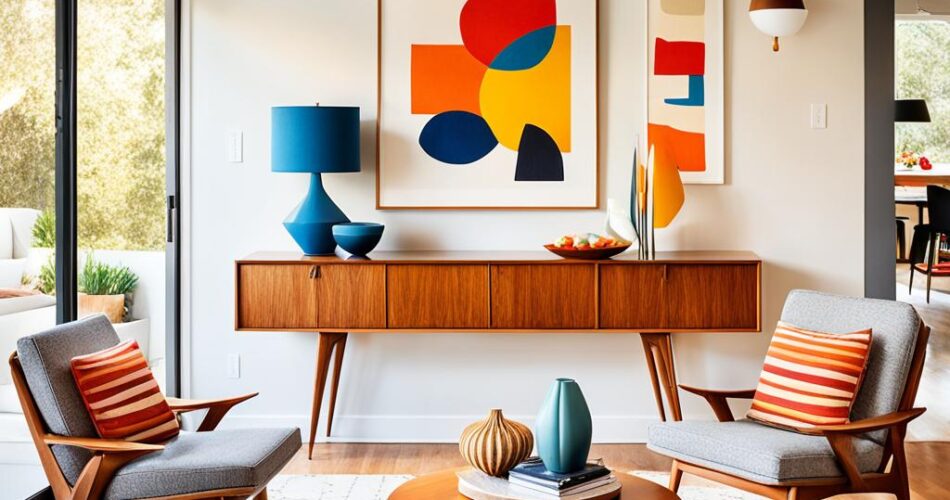Step back in time and embrace the timeless elegance of mid-century modern design. This iconic style, born after World War II, is now back in style. Homes across the U.S., from Los Angeles to New York, are embracing its clean lines and minimalist look, often featured in Architectural Digest.
Mid-century modern design tips often include using sleek lines, organic shapes, and elements like a Platner stool. design combines beauty with practicality, embodying the principles of midcentury modern aesthetics. It creates spaces that look great and work well. With Open floor plans are a hallmark of mid-century modern architecture. and geometric shapes, it makes moving around easy. Vintage pieces from the 1950s add a nostalgic touch to modern homes.
Architects and designers like Eyvind Finsen and Augusta Hoffman are at the forefront of this trend. They mix vintage and custom pieces to create unique spaces. These spaces capture the essence of mid-century modern, creating a relaxed oasis with a timeless style. mid-century modern look while fitting today’s lifestyle.
In Beverly Hills and New York City, mid-century modern is everywhere. You’ll see sleek Barcelona chairs, burl-wood sofas, and iconic lights that are both useful and beautiful. Natural materials like teak wood and stone bring a touch of nature to these designs.
Key Takeaways
- Mid-century modern design combines functionality with aesthetic appeal
- Open floor plans and geometric forms are key features of the style
- Vintage furniture pieces add authenticity to modern interiors
- Natural materials play a crucial role in mid-century modern design
- The style is adaptable to various locations, from urban apartments to suburban homes
- Renowned designers are reimagining mid-century modern for contemporary living
The Resurgence of Mid-Century Modern Design
Mid-century modern design has come back in a big way. This style was popular from the 1940s to the 1960s. It’s all about the look of the atomic age and Danish modern design. Now, it’s making a comeback in homes all over America.
Origins of the Mid-Century Modern Movement
After World War II, a new design movement started. It mixed Scandinavian design with American creativity. This created furniture and decor that was both useful and beautiful for modern homes.
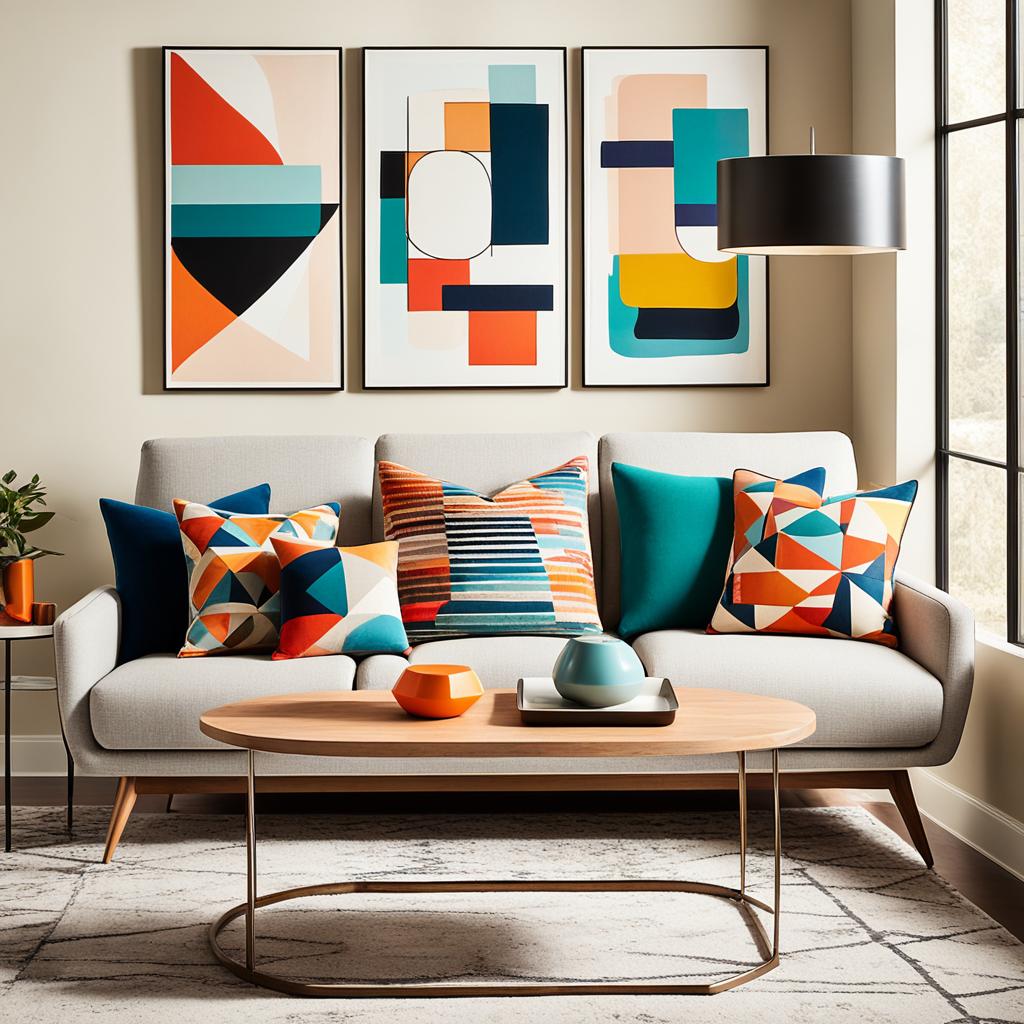
Key Characteristics of Mid-Century Modern Style
Mid-century modern design is known for its simple lines and natural materials. You’ll see a lot of wood, stone, glass, and plastic. It’s all about looking good and being practical, which is what people want today.
Why Mid-Century Modern is Trending Again
Several reasons explain why mid-century modern is popular again. Its classic look matches today’s tastes, and the Mad Men style has brought back its glamour. It’s simple and functional, fitting well with modern trends. People also like the nostalgic feel it adds to their homes.
| Design Element | Mid-Century Modern | Contemporary Adaptation |
|---|---|---|
| Color Palette | Bold, contrasting colors | Muted tones with bold accents |
| Materials | Teak, walnut, glass | Sustainable woods, recycled materials |
| Functionality | Multi-purpose furniture | Smart home integration |
Embracing Clean Lines and Minimalist Aesthetics
Mid-century modern design is back in style, winning over homeowners with its timeless look. It blends well with today’s trends, making spaces feel both cozy and peaceful. At its core, this style focuses on clean lines and simple interiors, ideal for modern homes.
Scandinavian minimalism plays a big role in this style. It’s all about clean spaces and practical furniture. The goal is to balance different design elements, letting each piece stand out.
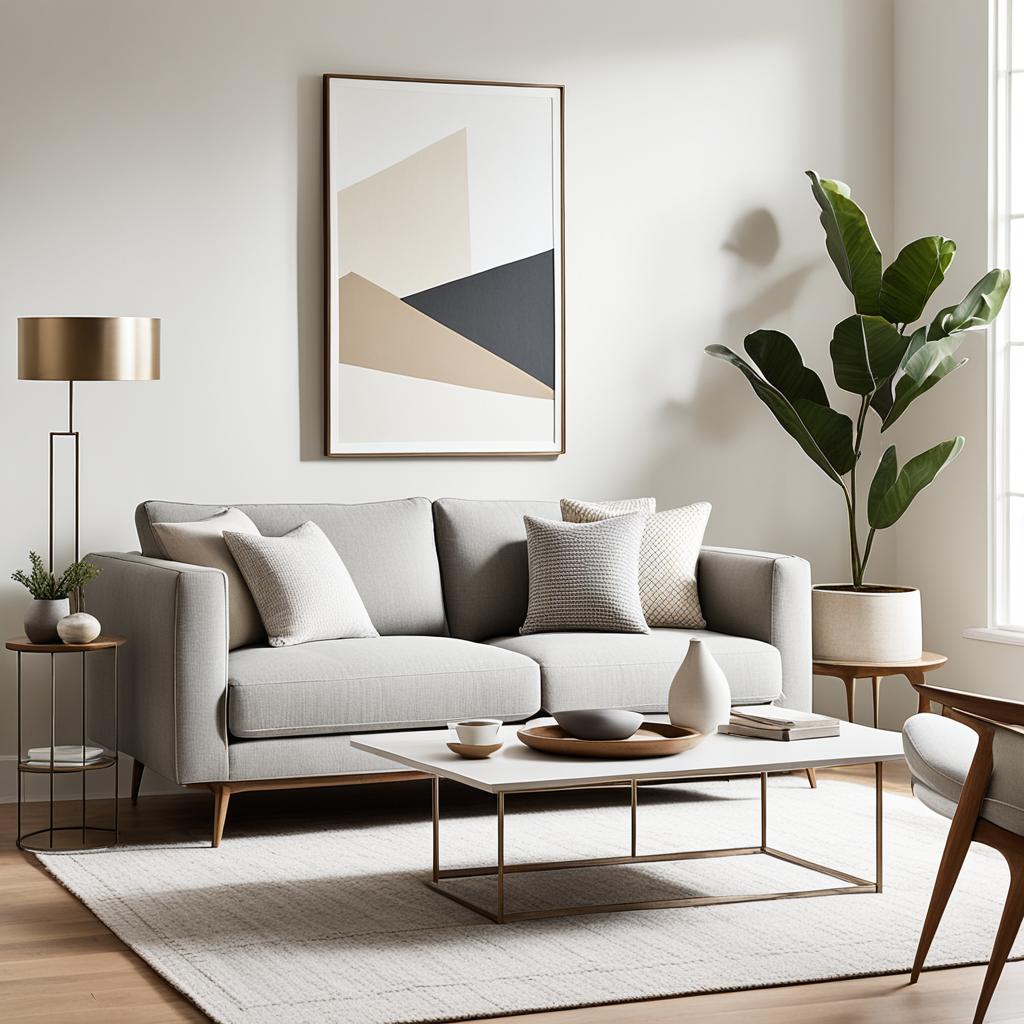
To get this look, think about adding pieces from Eternity Modern’s collection. The Mario Bellini Sofa and Extrasoft Low Profile Sofa show off the style’s simple beauty. These sofas are perfect for a minimalist living room, combining style with comfort.
“Minimalism in mid-century modern interiors promotes a sense of calm and openness, perfect for today’s busy lifestyles.”
When designing your space, start by decluttering and organizing. Choose furniture that fits your needs. Use neutral colors to make your furniture pop; this is a great design tip for achieving a cohesive look. Adding wood and leather brings warmth and texture to your space.
| Design Element | Characteristics | Examples |
|---|---|---|
| Furniture | Clean lines, functional design | Mario Bellini Sofa, Extrasoft Low Profile Sofa |
| Color Palette | Neutral, subdued tones | Beige, gray, white |
| Materials | Natural, organic textures | Wood, leather, glass |
| Lighting | Statement pieces, functional design | Sputnik chandeliers, floor lamps |
By picking the right pieces and using smart storage, you can make a space that captures mid-century modern minimalism. This approach makes your home look great and helps you live a clutter-free life, embodying the essence of midcentury style.
Incorporating Iconic Mid-Century Furniture Pieces
Mid-century modern furniture was popular from the 1930s to the 1960s. It’s still loved today for its timeless look. These pieces mix function, simplicity, and natural materials. This creates a style that’s both stylish and useful.
Eames Lounge Chair and Ottoman
The Eames Lounge Chair and Ottoman, made by Charles and Ray Eames in 1956, are symbols of mid-century comfort and style. They have molded plywood and leather, combining luxury with comfort. These chairs are a top choice for living rooms and studies.
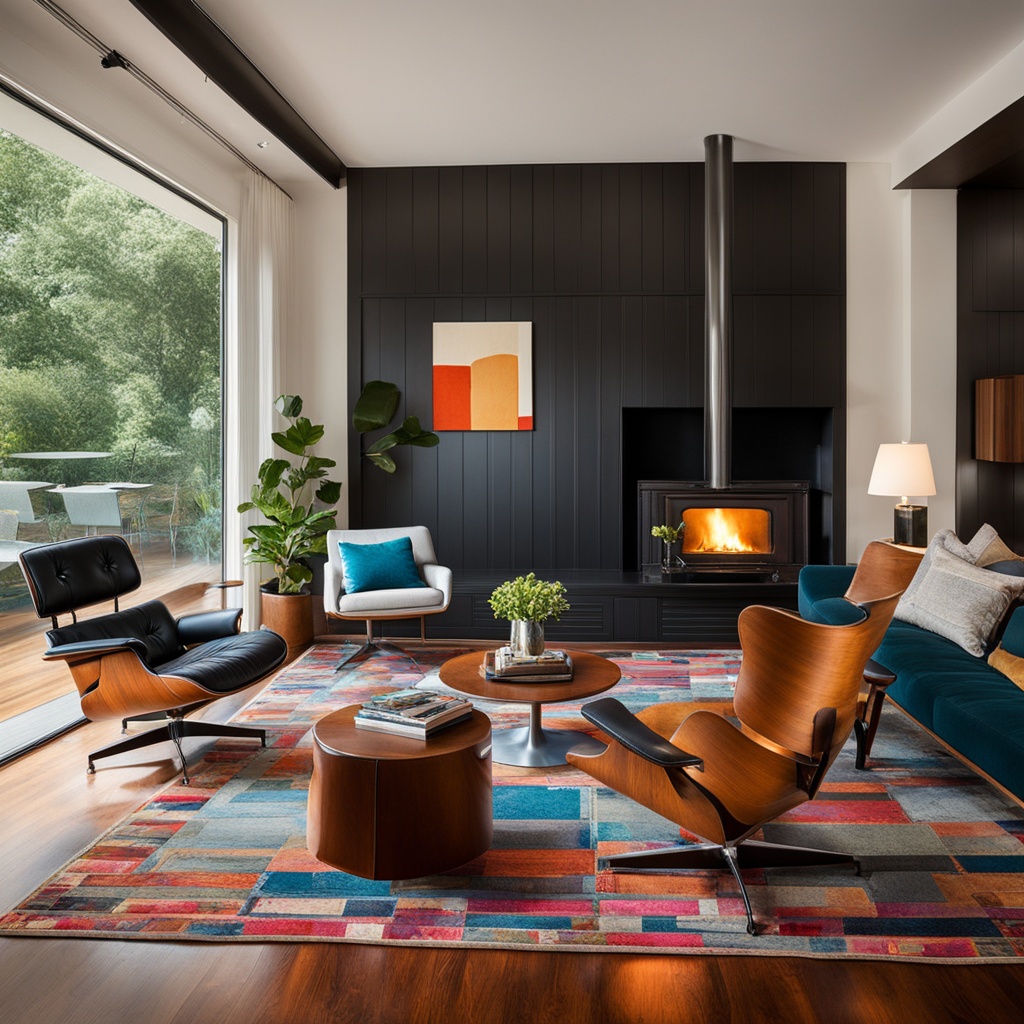
Noguchi Coffee Table
Isamu Noguchi’s coffee table was introduced by George Nelson to Herman Miller. It’s a sculptural work of art. The glass top and curved wood base make it a standout in any room. It shows how mid-century modern design combines beauty with usefulness.
Saarinen Tulip Table and Chairs
Eero Saarinen’s Tulip Table and Chairs reflect the era’s love for organic shapes and new materials. The pedestal design removes the clutter of traditional legs. This set fits well with other mid-century classics like the Barcelona chair or Florence Knoll sofa.
Other mid-century favorites include Pierre Jeanneret’s chairs for their clean lines. Warren Platner’s steel wire furniture adds texture to any space. For a budget-friendly update, try adding hairpin legs to your furniture.
Mid-Century Modern Color Palettes and Patterns

Mid-century modern design loves bold colors and eye-catching patterns. This style was popular from the 1930s to the 1960s. It features vibrant colors and geometric shapes for a unique look.
The color palette includes earthy tones like avocado green and mustard yellow. Warm browns balance these with brighter colors like teal and electric blue. Neutral colors like white, gray, and black are key to grounding these midcentury modern interiors. bold colors.
Atomic patterns are a distinctive feature of mid-century modern design and home furnishings from the half of the 20th century. and geometric shapes are key to mid-century modern design. These motifs are found in wallpapers, textiles, and artwork and are integral to midcentury design. They add visual interest and a retro charm. Abstract designs inspired by the atomic age are especially popular, showing the era’s interest in science and technology.
To get an authentic mid-century look, try these color combinations:
- Olive green paired with teak wood for a classic, natural feel
- Orange and blue as complementary colors for a playful vibe
- White and gold for a timeless, sophisticated aesthetic
- Bright green accented with neutrals for a fresh, nature-inspired space
Remember, less is often more in mid-century modern design. Pick a signature color as a focal point, much like the use of vibrant hues in mcm designs. Use patterns sparingly to create a balanced, stylish interior. This captures the essence of this enduring design movement, embedding the spirit of mcm.
Blending Natural Materials with Modern Elements
Mid-century modern design mixes natural materials with modern looks. This mix makes spaces timeless yet trendy. Let’s see how to add these elements to your home.
Teak Wood Accents
Teak furniture is a key part of mid-century modern style. It’s known for its warm colors and lasting quality. Adding a teak sideboard or dining table brings nature inside.
Integration of Stone and Glass
Stone and glass are vital in mid-century modern design. Big windows connect indoors with outdoors, and stone adds texture. A marble coffee table or a slate fireplace surround can help you achieve this look.
Organic Shapes in Furniture and Decor
Curved shapes make mid-century modern interiors feel softer. Look for kidney-shaped coffee tables, rounded sofas, or organic-shaped mirrors. These items bring visual interest and balance to the style’s clean lines.
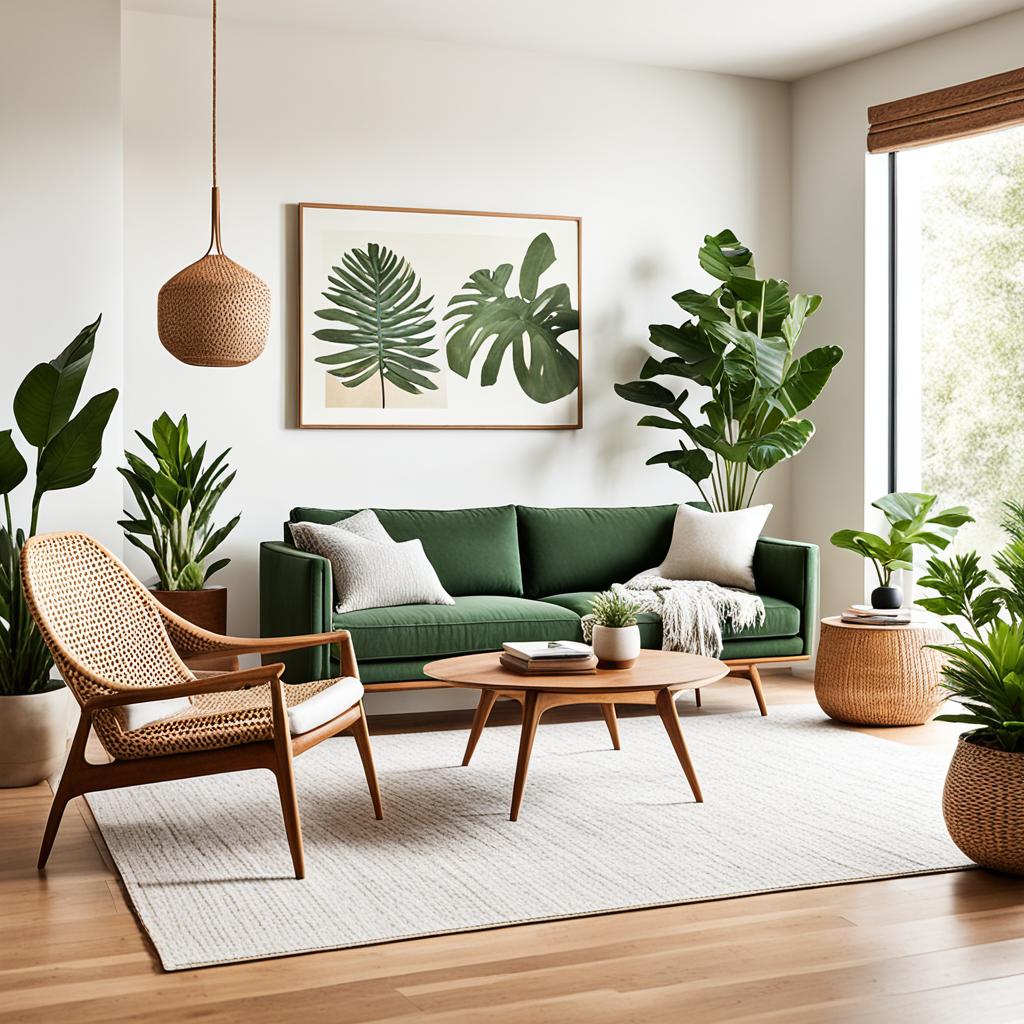
Wood accents are crucial in mid-century design. Use slatted wood screens or rosewood cabinets for warmth and texture. A glass-top table with wooden legs shows the style’s essence.
| Natural Material | Modern Element | Blend Example |
|---|---|---|
| Teak | Glass | Teak frame coffee table with glass top |
| Stone | Metal | Marble dining table with brass legs |
| Rosewood | Plastic | Rosewood credenza with colorful plastic handles |
By mixing natural materials with modern elements, you can make a space that’s both timeless and modern.
Creating an Indoor-Outdoor Connection
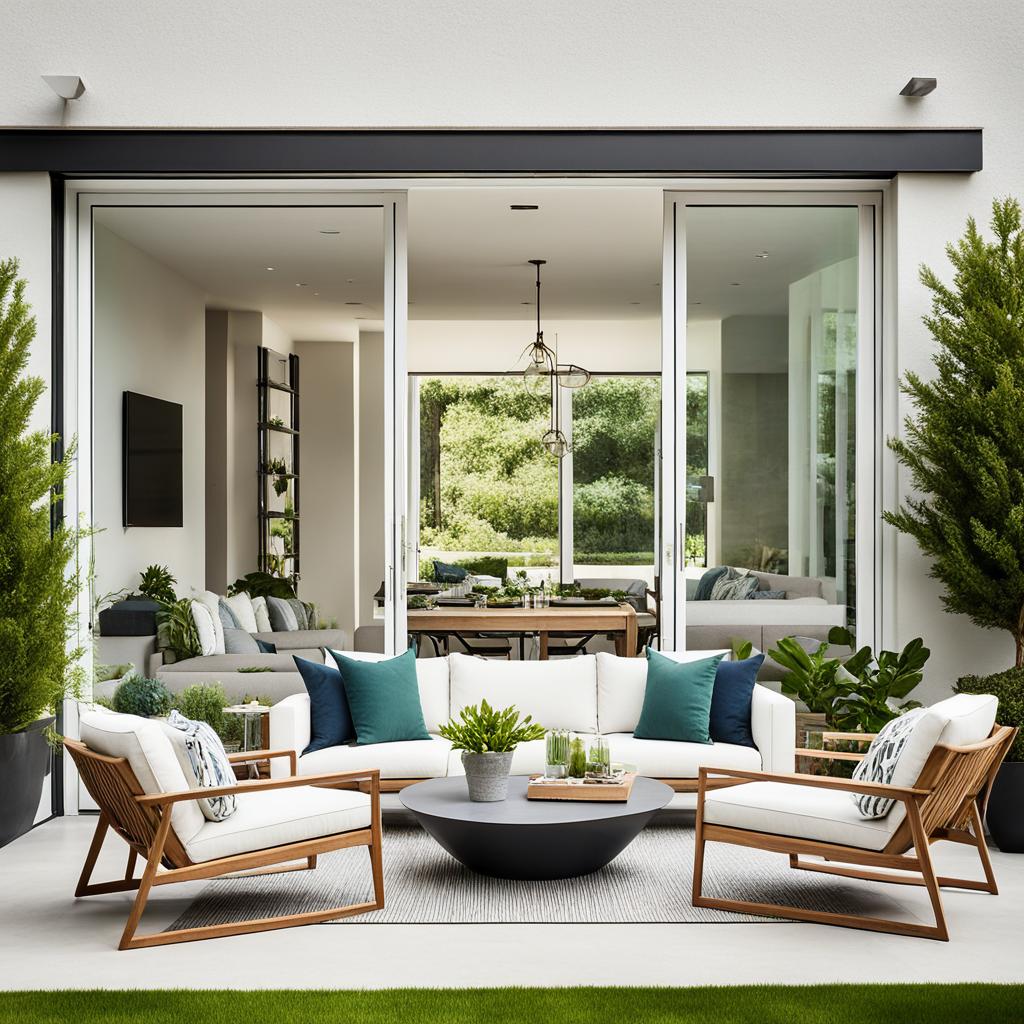
Mid-century modern design mixes indoor and outdoor spaces beautifully. This idea, made famous in Palm Springs, is still loved by homeowners. It’s all about making it easy to move between inside and outside, making the home look and work better.
Open floor plans are the base of this design. They remove walls to make rooms feel bigger and let in lots of natural light. Big windows are key, showing off beautiful views and making the inside and outside feel connected.
Architects like Richard Neutra were early fans of living indoors and outdoors together. They used big glass walls and sliding doors to open up to patios or gardens. This made homes feel bigger and brought people closer to nature.
“The integration of indoor and outdoor spaces enhances everyday life at home, creating a harmonious living environment.”
Today, we still love the idea of indoor-outdoor living. We add things like:
- Corner windows for wide views
- Matching floors inside and outside
- Private garden doors from bedrooms
- Doors that open fully in family rooms
These features make spaces look great and support a healthier lifestyle. Living indoors and outdoors together lets people enjoy the best of both worlds. It brings the comfort of inside and the fresh air of outside together.
| Design Element | Benefits |
|---|---|
| Floor-to-ceiling windows | Maximizes natural light, frames views |
| Open floor plans | Enhances spaciousness, improves flow |
| Sliding glass doors | Seamless indoor-outdoor transition |
| Consistent flooring | Visual continuity, blends spaces |
Lighting Fixtures: A Mid-Century Modern Focal Point
Mid-century modern light fixtures are eye-catching in any room. They mix style with function, bringing a unique vibe. From sputnik chandeliers to sleek floor lamps, these designs still wow people today.
Sputnik Chandeliers
Sputnik chandeliers capture the 1950s and 60s space-age look. They have many arms with bulbs that look like a starburst. Prices for these iconic lights range from $200 to $2,500, with some costing even more.
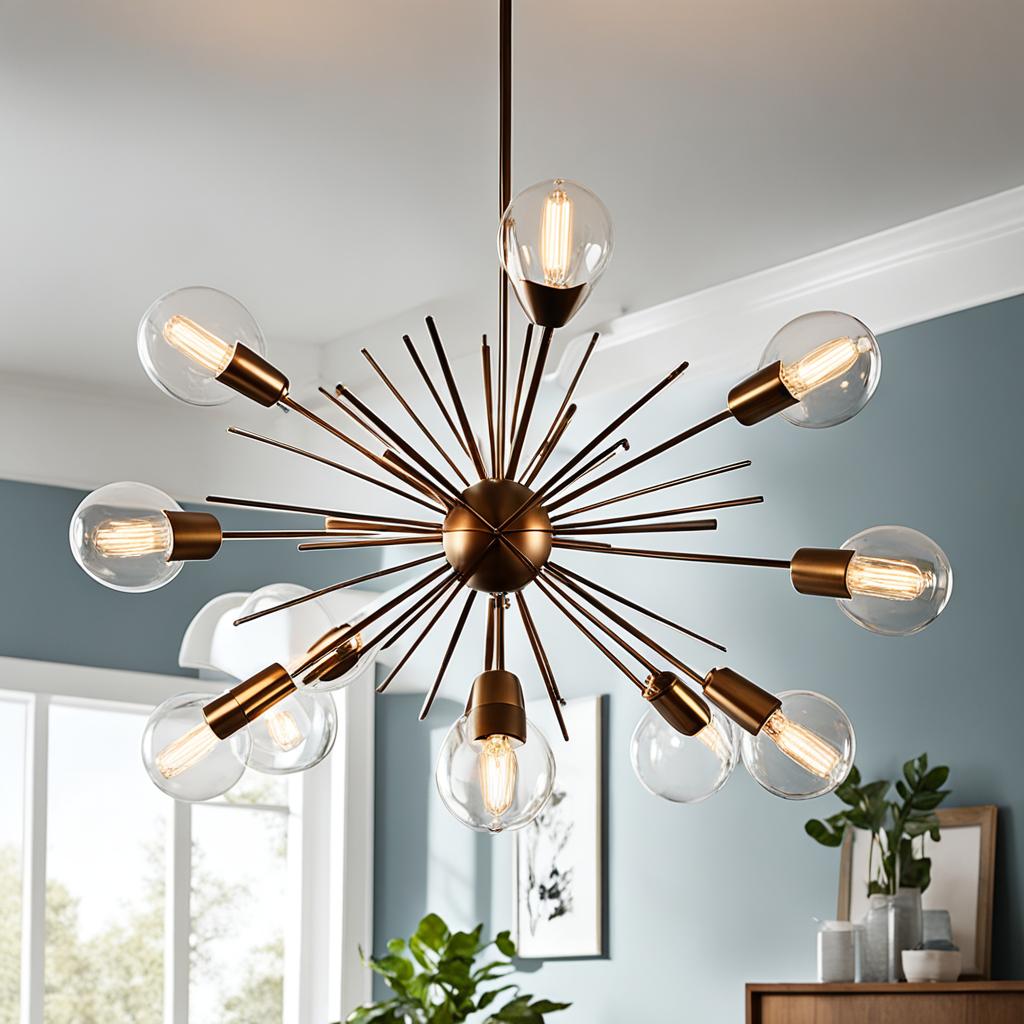
Arco Floor Lamp
The Arco Floor Lamp is a classic by Achille Castiglioni. It’s both elegant and practical, lighting up a room without needing to be mounted on the ceiling. This lamp is a favorite for modern homes, priced between $1,000 and $3,000.
Nelson Bubble Lamps
George Nelson’s Bubble Lamps bring a soft touch to mid-century lighting. Their shapes spread light gently, making any space warm and inviting. You can find these lamps in different sizes and styles, costing from $300 to $1,500.
| Fixture Type | Price Range | Key Features |
|---|---|---|
| Sputnik Chandelier | $200 – $2,500+ | Multiple arms, exposed bulbs |
| Arco Floor Lamp | $1,000 – $3,000 | Arching design, marble base |
| Nelson Bubble Lamp | $300 – $1,500 | Organic shapes, soft glow |
These mid-century modern fixtures are very popular, often selling out quickly. They come in simple and complex designs, fitting many tastes. They keep the era’s clean lines and minimalist look.
Mid-Century Modern Art and Wall Decor
Mid-century modern art and wall decor bring the atomic era’s spirit into your home. This style, from the 1940s to the early 1970s, has clean lines and pleasing geometric patterns. The vibrant colors and abstract art can turn any space into a modernist artwork gallery.
Vintage posters from the 1950s and 1960s add authentic mid-century flair. These posters have bold graphics and bright colors, capturing the era’s look. For a refined touch, consider abstract art inspired by Jackson Pollock or Mark Rothko, key figures in mid-century modern art.
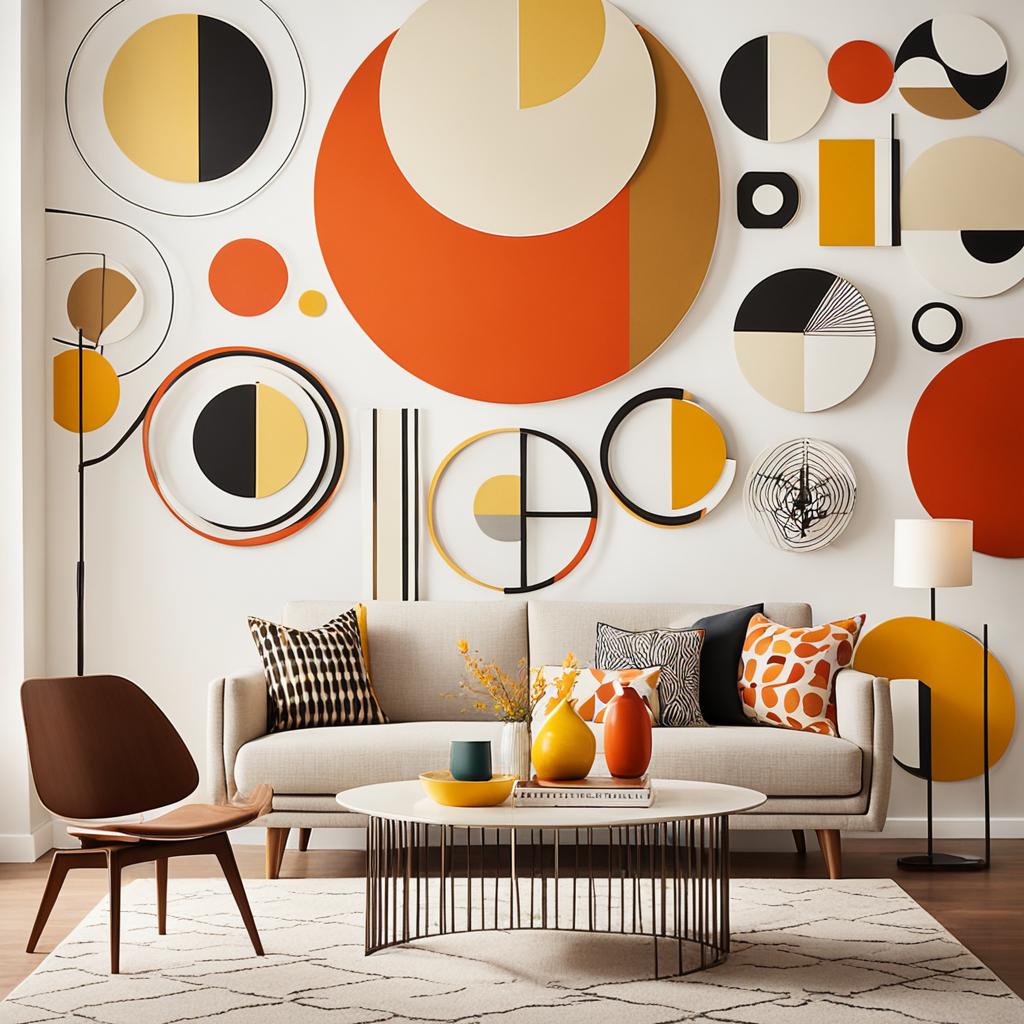
Geometric patterns are key to mid-century design. Wall art with shapes like circles, triangles, and diamonds adds visual interest. These pieces often use bright colors like reds, yellows, and blues, making the space lively.
“Mid-century modern wall décor is versatile and can work in various settings, from homes to offices, providing color and mental stimulation.”
When picking mid-century modern wall art, consider these popular options:
- Abstract expressionist paintings
- Minimalist sculptures
- Floating bowl wall art
- Canvas wall art sets
| Art Type | Price Range | Popular Artists |
|---|---|---|
| Framed Prints | $21.68 – $478.66 | Eline Isaksen, Joan Miro |
| Canvas Sets | $100 – $300 | Various In-house Artists |
| Vintage Posters | $50 – $200 | 1950s-1960s Reproductions |
By adding these elements, you can make a stylish, mid-century modern space. It reflects the creativity and innovation of the atomic era.
Modernizing Mid-Century: Adapting the Style for Contemporary Living
The timeless appeal of mid-century modern design still draws in homeowners and designers. Today, it combines vintage charm with contemporary classics. This mix creates spaces that feel both nostalgic and fresh. It’s a perfect blend of retro looks and modern functionality.
Mixing Vintage and Modern Pieces
Designers are now mixing mid-century furniture with today’s trends. Clean lines and peg legs are still in, but now there’s a focus on deeper, softer seating for more comfort. Clients often ask for changes like wider arms and higher sofa seats. These changes keep the iconic look while fitting today’s lifestyle.
Updating Mid-Century Designs with New Materials
Modern pieces now use sustainable materials, which is good for the planet. Designers are trying out plywood, glass, and metal, keeping the style’s organic feel. Adding leather piping and artistic pillows gives a modern twist to transitional furniture. A simple color scheme and bold art pieces add depth to these updated designs.
Incorporating Smart Home Technology
Adding smart home tech to mid-century inspired homes is changing how we live. Features like voice-controlled lights and automated climate systems blend well with retro looks. This mix of old and new makes homes stylish and functional for today’s lifestyle.
